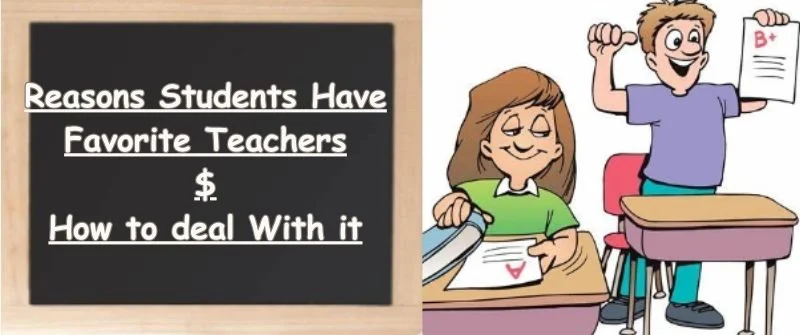Students can form preferences for particular teachers, just as teachers may have favorites among their charges. This article examines the causes of children having favorite teachers and provides advice on handling this dynamic.
Creating a more stimulating and enjoyable learning environment for everyone can be easier if you are aware of the aspects that influence students’ choices.
Do Students Have Favorite Teachers?

Teacher favoritism frequently has a lasting effect on student’s academic progress and personal development.
It is crucial to remember that this choice does not lessen the importance or efficacy of other teachers in pupils’ lives.
In the same way that people tend to gravitate toward certain persons, certain professors may be preferred by students for various reasons.
These elements may include the instructor’s teaching style, approachability, interpersonal skills, excitement, and pleasant classroom environment.
Why Do Students Have Favorite Teachers?
There are many different reasons why students may have favorite professors. These factors may be influenced by the instructor’s instructional approach, character, and capacity to foster a supportive and stimulating learning environment.
Here are five typical elements that influence whether pupils have favorite teachers:
Teaching Style: A teacher’s teaching style can greatly impact student engagement and interest.
Teachers who employ interactive and hands-on teaching methods, incorporate multimedia resources, and encourage active participation tend to captivate students’ attention and make learning enjoyable.
Approachability and Supportiveness: Students often appreciate approachable, understanding, and supportive teachers.
More importantly, teachers who are open to questions, provide guidance, and foster a safe and inclusive classroom environment create a sense of trust and make students feel valued and supported.
Personal Connection: A strong personal connection can develop between students and teachers when there is mutual understanding and rapport.
Better yet, teachers who take the time to get to know their students, show genuine care and interest in their wellbeing, and establish a positive teacher-student relationship often become favorites among students.
Enthusiasm and Passion: Teachers with enthusiasm and passion for their subject matter can inspire students. Their energy and genuine love for what they teach can be contagious, igniting curiosity and motivation in students and making the learning experience more enjoyable.
Fairness and Respect: Students appreciate teachers who demonstrate fairness and treat all students respectfully.
Teachers who provide equal opportunities, give constructive feedback and maintain a consistent and transparent grading system are often respected and favored by students.
What are the Characteristics of a Favorite Teacher?

The characteristics of a favorite teacher can vary among students, but here are four commonly appreciated qualities:
- Approachability and Support: A favorite teacher fosters a friendly atmosphere for students and is frequently approachable. They encourage students to ask questions, offer advice and support when necessary, and create a safe environment.
- Engaging Teaching Style: A student’s favorite teacher has an interesting teaching style that captures their interest and encourages involvement. They employ various teaching techniques to make learning engaging and fruitful, including interactive conversations, practical exercises, visual aids, and technology.
- Strong Teacher-Student Relationship: A favorite teacher forges close bonds with their students. They take the time to get to know their pupils personally, demonstrate genuine concern and interest in their wellbeing, and build a relationship based on mutual respect and trust.
- Also, this encourages students to work hard and pursue academic success while fostering a good learning atmosphere.
- Passion and Enthusiasm: A favorite teacher exhibits a genuine passion for their subject and teaching. They convey enthusiasm and inspire students by sharing their knowledge and love for the subject matter. Their energy and excitement create an engaging atmosphere that motivates students to participate and develop a genuine interest in the subject actively.
How Teachers Deal With Favoritism?
When teachers notice bias in their classes, they must address the situation to guarantee fairness and equitable treatment for all students. Here are four methods educators can use to combat favoritism:

1. Self-reflection and Awareness
Teachers must engage in self-reflection to uncover any unintentional prejudices or preferences they may have acquired toward particular students.
Teachers can actively attempt to mitigate partiality and promote an inclusive learning environment by becoming aware of their tendencies.
2. Consistent Rules and Expectations
Clear norms, expectations, and grading standards must be established and communicated to all students by teachers. Teachers can lessen the possibility of partiality and establish a fair playing field for everyone by guaranteeing consistency and transparency.
3. Equitable Distribution of Attention and Resources
Teachers should strive to distribute their attention and resources equally among all students. This includes giving equal opportunities for participation, providing timely feedback, and allocating resources and support based on individual needs rather than personal biases.
4. Building Positive Relationships with all Students
Teachers should develop positive relationships with each student. Teachers can create a supportive environment where every student feels valued and appreciated by getting to know their students individually and understanding their strengths, challenges, and interests.
How to be students’ Favorite Teacher
Here are four strategies to become a student’s favorite teacher:

Establish a Welcoming Classroom Environment
Create a welcoming and inclusive classroom where students feel safe to express themselves, share their thoughts, and take risks in their learning journey.
Take time to know your students individually, show genuine interest in their lives, and establish a personal connection. This helps to build trust and understanding.
Engage and Inspire
To keep students interested and motivated, use a variety of teaching techniques such as interactive conversations, group activities, multimedia resources, and hands-on learning opportunities.
Encourage the pupils to research their interests, pose questions, and ask more questions. Develop a passion of study and a feeling of curiosity.
Provide Individualized Support
Differentiate your instruction to meet the diverse needs of students. Provide opportunities for students to learn in ways that align with their strengths and preferences.
Provide constructive feedback that highlights students’ strengths and offers guidance for improvement. Show that you value their efforts and are invested in their progress.
Show Care and Support
Demonstrate understanding and empathy for students’ challenges and concerns. Show genuine care for their well-being, both academically and personally.
Create an open-door policy where students feel comfortable approaching you with questions, concerns, or requests for assistance.

Joseph is a freelance journalist and a part-time writer with a particular interest in the gig economy. He writes about schooling, college life, and changing trends in education. When not writing, Joseph is hiking or playing chess.
